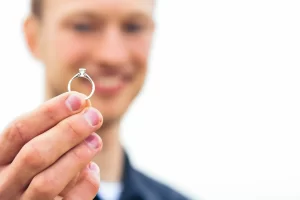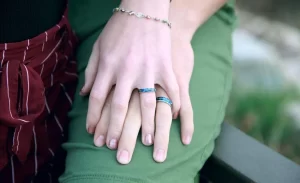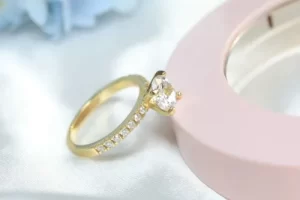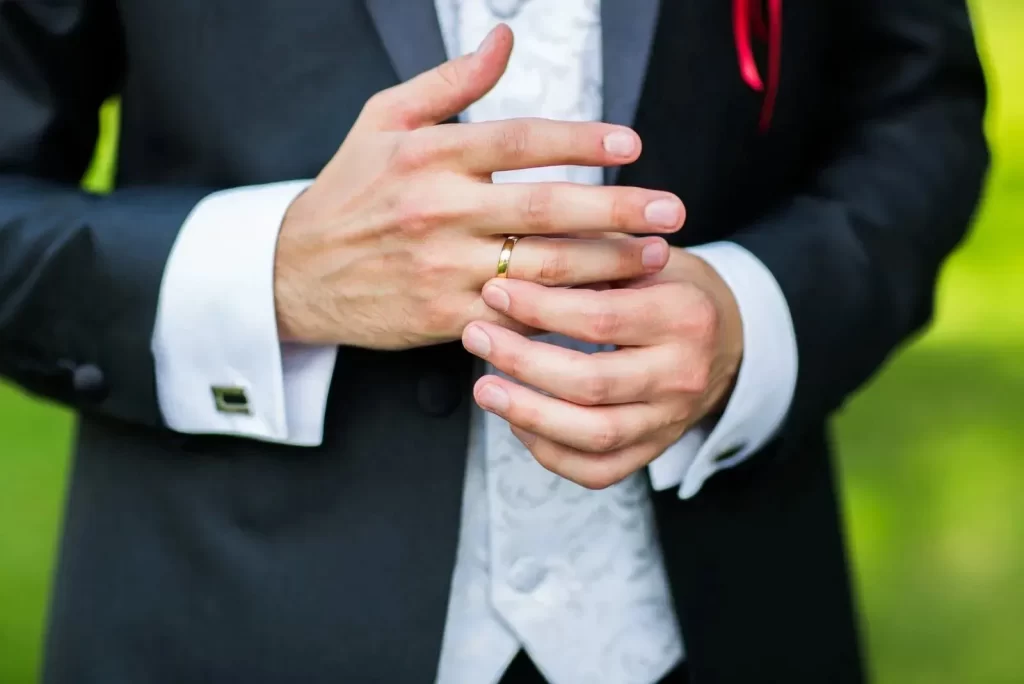Historically, engagement rings have mainly been worn by women. But traditions are shifting as ideas about gender norms and equality evolve. More men are embracing engagement rings, whether as a symbol of commitment in their relationship or to make a statement about sharing that commitment equally.
As cultural attitudes change, engagement rings for men grow in popularity across various demographics.
Historical Reasons Men Don’t Wear Engagement Rings
For centuries, weddings served economic and social purposes beyond celebrating love. Attitudes ingrained from those eras still shape modern traditions, including who wears an engagement ring.
Women as Property in Marriage
Engagement rings date from Roman times when marriages secured business deals. Fathers gave their daughters iron bands to represent the contractual agreements between men exchanging their “property.” These bands didn’t symbolize the woman’s commitment, only the men’s.
This notion of women as “claimed” objects persisted for centuries. Rings denoted that a woman was “off the market” for other suitors. Men didn’t wear rings because they remained free agents.

Engagement Rings as Collateral
By the early 20th century, broken engagements could ruin a woman’s reputation and marital prospects. Laws allowed women to sue ex-fiancés for breach of promise. Expensive engagement rings served as insurance, a form of collateral a woman kept if the man backed out.
These laws upheld the sexist idea that an engaged woman was “damaged goods” if single again. A man’s reputation didn’t suffer the same damage. He’d face no similar ostracization or lowered value on the marriage market.
“A Diamond is Forever” Marketing
The famous De Beers slogan that “A Diamond is Forever” linked the gems with marriage’s “forever” commitment. Their ads helped define engagement rings as glittering diamonds, given by men to symbolize the permanence of their marital promise.
De Beers’ marketing spurred the tradition we now consider classic. While they did advertise diamond rings for men too, the concept has yet to catch mainstream attention. Diamonds shaped the modern engagement ring into a gift men give women.
Shifting Cultural Norms
Society has gradually rejected archaic assumptions about prescribed gender roles and relationship dynamics. Younger generations emphasize equality between partners. Alongside these shifting attitudes, long-held traditions face well-deserved criticism and change.
Growth in Men’s Engagement Rings
Rising numbers of men now wear engagement rings, often symbolizing their equally serious commitment. Some also see it as an emblem of their progressive values or rejection of outdated norms.
For many couples, a ring’s meaning depends not on the wearer’s gender but on the commitment’s sincerity. These couples want visible proof they both pledged their “forever” to each other.
Women Proposing More Often
Another shift is the gradual increase in women proposing to men. While still uncommon, it’s viewed more positively than in the past. As ideas about gender equality evolve, proposal traditions face less rigid expectations.
With more women proposing, it makes sense for more men to sport engagement bling. If she gifts him a ring, shouldn’t he wear one too? Mutual rings reinforce the joint act of committing.
Same-Sex Couples Wearing Rings
Same-sex couples have additional cause to disregard old traditions as they create new ones that work for their relationships.
With two men or two women, engagement rings lose any inherently gendered symbolism. They become a sentimental token of devotion between two people in love, attaching the same meaning regardless of which partner wears it.

Men Embracing Non-Traditional Jewelry
Alongside shifting cultural norms, men face fewer taboos about jewelry deemed too “feminine” in the past. Rules once dictated that certain metals, designs, or gemstones were off-limits for men.
As rigid gender stereotypes fade, men express themselves through non-traditional jewelry without fear of judgment. The expandable men’s style options translate to engagement rings, too. Men may opt for alternative metals over gold or unconventional stones over diamonds.
Men’s Engagement Ring Styles
Luckily, the possible styles are plentiful for men ready to sport an engagement ring. Whether preferring understated or flashy, masculine aesthetics or gender-neutral designs, men have many ways to show off this symbol of their forever commitment.
Classic Metal Bands
A simple yet sophisticated metal band makes a timeless statement. Channels of gleaming gold, silver, titanium, or platinum perfectly complete an elegant minimalist look. These understated bands work for men wanting a low-profile ring or to match existing jewelry.
Minimalist Designs
Minimalist engagement rings offer eye-catching styles in an utterly simplified form. A popular look features a plain metal band with one petite gemstone, often embedded for smooth edges rather than raised on prongs. The muted palette keeps the focus on exquisite workmanship.
These quietly dazzling rings attract men who want something unique but not showy. Their restrained aesthetic magnifies the symbolism of lasting devotion.
Modern Metal Choices
Beyond classic metals, men can pick trendier options better suit their tastes—contemporary metals like tungsten, titanium, steel, cobalt, and platinum craft unique modern rings.
The metal itself makes a statement, its color and sheen speaking the wearer’s style. These industrial, high-tech metals project savvy sophistication. Their sleek durability promises resilience against time, an apt feature for an eternal commitment.

Statement Rings
On the flashier end, statement rings give men chances to pronounce their engagement boldly. Large, brilliant gems command attention in vibrant colors like emerald, ruby, or sapphire. These bright jewels pop against shiny metals and wide bands.
Statement rings broadcast fun confidence, their eye-catching sparkle announcing a momentous milestone. Men can shape one-of-a-kind rings matching their custom personalities.
Traditions Around the World
While men wearing engagement bands are still non-traditional in most Western cultures, other countries have well-established practices of exchanging rings.
Latin American Traditions
Several Latin American cultures expect both men and women to wear engagement rings. The bands hold special meaning, serving as engagement and wedding rings instead of adding another ring later.
In Chile, couples wear these rings on their right hands while engaged. Then, they shift the rings to their left hands on their wedding day to embody their new marital union.
Sweden’s Simple Bands
Swedish brides and grooms traditionally exchange plain silver or gold bands at their engagements. Their minimalist style spotlights the betrothal’s significance rather than the jewelry’s monetary value. Solid metal conveys enduring strength better than sparkling stones.
Right Hand Rings in Chile
A unique Chilean custom places engagement rings on the right finger until the wedding. Moving the ring to the left hand on the big day seals the lifetime pact. This gives the ring extra symbolism, physically transitioning positions as romantic intentions shift from tentative to permanent.
Why This Tradition is Changing
Beyond global cultural influences mixing ideas, central reasons explain the growing acceptance of men’s engagement bands—their rising popularity links to evolving beliefs about equality, independence, and individuality.
Symbol of Equality
For progressive couples, mutual rings demonstrate their commitment to shared values like fairness, partnership, empathy, and compromise. These pillars nurture strong bonds.
Rings for both parties reject outdated norms of men actively pursuing passive women. Now, everyone participates equally in building happily lasting relationships.
Showing Commitment
An engagement ring shows the world that you’re in a committed relationship. It flags you as off-limits to other romantic prospects. Rings confer a level of security, a confirmation you and your partner choose each other.
These intentions hold regardless if you’re a man or woman. Rings help couples feel certain of mutual devotion; vows made tangible they can see and touch.
Strengthening Relationships
Research on gift-giving shows that presents emotionally knit people closer together. The care, effort, and meaning behind choosing an engagement ring make the object even more bonding.
Rings stand for promises, hopes, vulnerability, and trust—all ingredients fostering intimacy. They spark joy whenever they catch your eye, recalling the sincerity of the giver’s pledge.
Making a Shared Statement
An engagement ring broadcasts your innermost feelings to your beloved. But it also tells the whole world too.
It’s a public announcement of your most tender, private, sacred intentions. It loudly proclaims without words, “We plan to stay devoted forever, bound by our wildest love!”
What better romantic declaration could there be? Shouldn’t men get to join women in proudly displaying this badge of courageous sentimentality?
Celebrity Trendsetters
As with many trends, celebrity culture contributes to major influence, too. Famous couples like actor Tom Daley or singer Ed Sheeran normalized men’s engagement jewels by sporting their own.
Male celebrities wearing rings smash lingering stereotypes that bands are strictly feminine accessories. Their high-profile example sways mainstream preferences.
Conclusion
Traditions constantly gradually evolve and change with the times. Engagement rings for men offer the latest adaptation reflecting modern values of equality, individuality, and inclusivity. What symbol could better represent healthy relationships built on mutual trust, understanding, and respect between loving partners?
As more men don their notable bands commemorating that pivotal decision to commit forever, they join women in visibly declaring devotion against all odds or obstacles. Rings mark the first step in celebrating promises of lifelong partnership and happiness.
FAQs
Why are engagement rings traditionally only for women?
Historically, marriages served economic and political purposes beyond romance. Rings signified men’s legal ownership over women as property. Outdated attitudes assuming rigid gender roles influenced these traditions.
Do men want to wear an engagement ring?
Yes! Many modern men want engagement rings for various reasons — as a token of their progressive values, to demonstrate equality in their relationship, or simply to confirm publicly their joyful commitment.
What styles of men’s engagement rings are popular?
Men’s rings showcase personal style with designs ranging from thin plain bands to single-embedded gems to chunky rings with vibrant rainbows of glittering stones. Channels of sleek metals or sparkling jewels all make unique statements.
What cultures have traditions of men wearing engagement rings?
Several Latin American countries expect men and women to wear engagement rings that transition into wedding rings later. Chilean couples wear these on their right hand while engaged, moving them to the left at marriages.
Why are attitudes changing around male engagement rings?
Evolving beliefs embracing equality in relationships and society influence traditions to adapt accordingly. Rings become symbols of jointly pledged devotion regardless of gender, not ownership markings.

